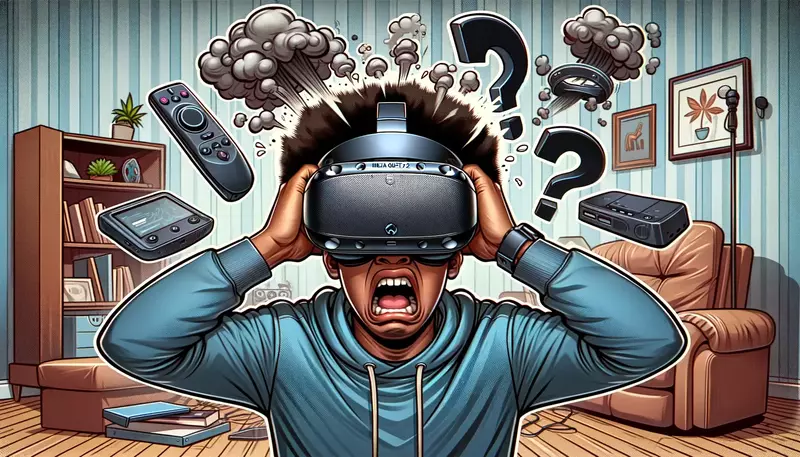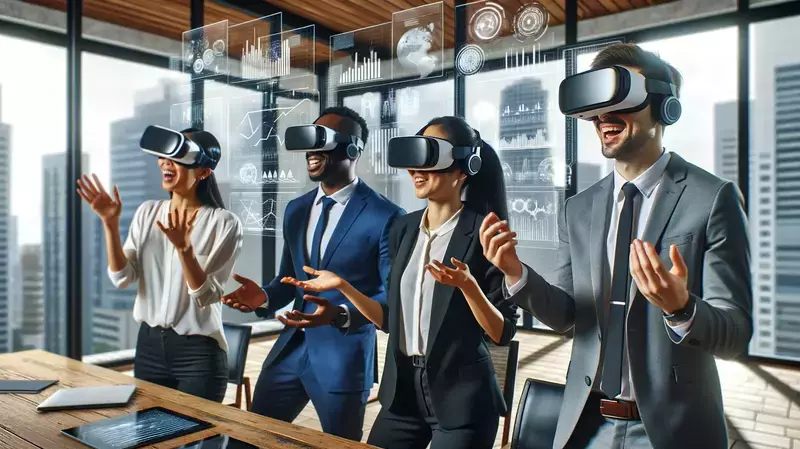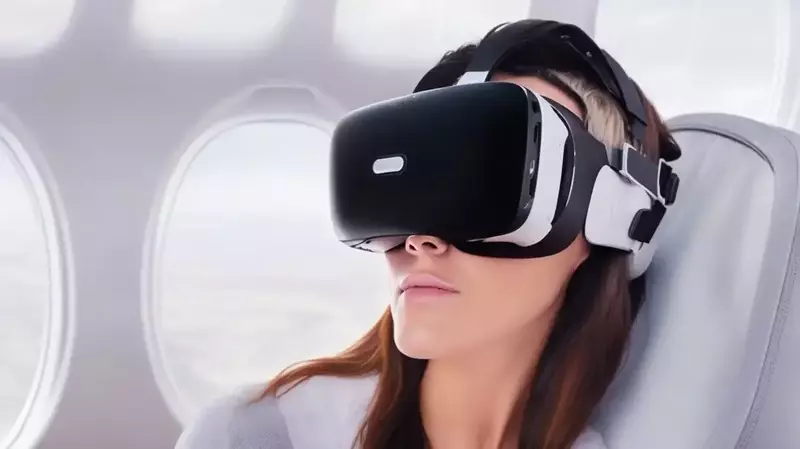Can you see virtual reality with one eye? This intriguing question often arises among gamers, explorers, and those who want to learn about the immersive world of virtual reality.
In this blog post, we will delve into the fascinating aspects of VR technology and its interaction with our visual perception.

Key Takeaway:
You can see virtual reality with one eye, but it won’t provide the same level of immersion as using both eyes. Monocular vision has some limitations compared to binocular vision, but adjustable settings and software solutions are available for those who need monoscopic visuals rather than stereoscopic ones.
What is Virtual Reality?
Using specialized equipment such as a headset with a screen or gloves fitted with sensors, virtual reality (VR) is an immersive computer-generated simulation of three-dimensional environments that can be interacted with seemingly realistically.
This immersive technology has gained significant popularity in recent years, particularly within the gaming and entertainment industries.
Types of Virtual Reality Systems
- Fully Immersive: These systems provide users with the most comprehensive VR experience by utilizing high-resolution displays along with advanced tracking technologies to create realistic environments that closely mimic real-world settings.
- Semi-Immersive: Semi-immersive systems offer some degree of immersion but typically do not include full-body tracking capabilities. They often use large projection screens or multiple monitors to display virtual environments while still providing interactive elements via handheld controllers or motion-sensing devices.
- Non-Immersive: Non-immersive VR experiences are usually limited to desktop computers where users view virtual worlds on their monitor screens without wearing any specialized hardware. Examples include online games and 360-degree videos viewed through web browsers.
Main Components of Virtual Reality Systems
- Vision System: The vision system comprises headsets equipped with high-resolution displays that provide users with a wide field of view and accurate depth perception. Examples include the Oculus Rift S and HTC Vive Pro Eye.
- Audio System: Audio systems in VR setups use spatial audio technology to deliver realistic soundscapes, allowing users to perceive sounds coming from specific directions within the virtual environment.
- Motion Tracking System: Motion tracking systems capture user movements and translate them into actions within the virtual world. This can be achieved through external sensors or built-in cameras on headsets like the PlayStation VR.
- User Input Devices: Input devices such as handheld controllers, gloves, or body suits enable users to interact with objects in their virtual surroundings by providing tactile feedback and gesture recognition capabilities.
VR offers an exciting opportunity for people to explore new realms, hone their abilities, or just have a blast while feeling more present in digital settings.
Immersive tech with the potential to transform how we engage our surroundings, virtual reality has stirred up a lot of excitement. Grasping the fundamentals of virtual reality allows us to comprehend its potential and boundaries better. Next, let’s explore if you can see virtual reality with one eye.
How Does Virtual Reality Work?
Virtual reality (VR) works by creating an immersive experience for the user, allowing them to interact with the virtual world through sight, sound, and touch. This is achieved through the use of specialized hardware such as headsets, controllers, and other input devices.
This section will explore how these components work together to provide a seamless virtual reality experience.
The Role of VR Headsets
A crucial component in any VR setup is the headset. These devices are worn on your head and contain screens that display images directly in front of your eyes.
Advanced-level professionals with an IQ of 150 use sophisticated lenses and high-resolution displays to create a wide field of view that envelops the peripheral vision when wearing VR headsets.
Some popular examples include the Oculus Rift S, Valve Index, and PlayStation VR.
Motion Tracking Systems
To make users feel like they’re truly part of a virtual environment, motion tracking systems are employed to accurately monitor their movements in real-time. There are two main types:
- Outside-in tracking: External sensors or cameras around you track your movement from outside while wearing markers on your body or equipment.
- Inside-out tracking: Cameras or sensors built into the headset itself track both its own position relative to its surroundings and the position of handheld controllers.
Controllers and Input Devices
Users need input devices that translate their physical actions into digital commands to interact with the virtual world. These can range from simple button-based controllers to more advanced motion-sensing devices like HTC Vive Controllers or Oculus Touch Controllers.
Some systems even use haptic feedback technology to provide tactile sensations, further enhancing the VR experience.
Software and Content Creation
The final component for creating a VR experience is the software. Developers create virtual environments using powerful game engines such as Unity 3D or Unreal Engine 4, specifically designed to create immersive experiences.
These tools allow developers to build detailed worlds complete with realistic physics, lighting, and sound effects that help bring your VR experience to life.
Virtual reality can be a perplexing technology to grasp, yet it provides the ability to traverse and become fully immersed in an alternate universe. To gain insight into the implications of this technology, let us consider if it is possible to view virtual reality with one eye.
Can You See Virtual Reality With One Eye?
Yes, it is feasible to view virtual reality with a single eye. However, this will not provide the same level of immersion as using both eyes would offer.
The best way to experience virtual reality is to use both eyes to get the full effect of depth perception and spatial awareness.
Monocular Vision in VR Experience
Monocular vision, or seeing with only one eye, can still allow users to engage with a virtual environment, but there are some limitations compared to binocular vision (seeing with both eyes).
For example, monocular cues such as size and perspective can help create an illusion of depth within the VR experience, but they may not be as effective as binocular cues like convergence and stereopsis, which rely on input from both eyes.
Adjusting Settings for One-Eyed Users
If you have limited vision in one eye or prefer using just one eye when experiencing virtual reality due to personal reasons or comfort concerns, there are options available for you too.
Some VR headsets come equipped with adjustable settings that cater specifically to those needing monoscopic visuals rather than stereoscopic ones – check your device’s user manual or online forums for guidance on configuring these adjustments accordingly.
IPD Adjustment:
- The Inter-Pupillary Distance (IPD) setting adjusts the distance between lenses inside your headset so that images align correctly according to your unique facial structure; this helps ensure optimal clarity during gameplay regardless if you’re using mono- or bi-ocular viewing modes.
Software Solutions:
- Some VR applications offer in-game settings that allow users to toggle between monoscopic and stereoscopic modes, making it easier for one-eyed individuals to enjoy the immersive experience without feeling left out.
Adjusting your headset and software settings allows you to tailor the VR experience to suit your individual needs and maximize immersion. Don’t be shy to explore various configurations until you find the one that suits your vision best.
Though viewing VR with one eye is possible, the total immersion can only be achieved when both eyes are utilized. Next, let’s consider the advantages of using two eyes to view virtual reality.
What Are The Benefits Of Seeing Virtual Reality With Two Eyes?
Seeing virtual reality with two eyes gives users an enhanced immersion and realism level due to increased depth perception and spatial awareness.
When both eyes are utilized, the brain can take in and assimilate data from each eye individually before combining it into a single image with an additional dimension of depth.
This allows for a more realistic experience within the virtual reality (VR) environment.
In addition to improved depth perception, using both eyes in VR offers several other benefits:
- Better object tracking: Having two eyes open allows for better tracking of objects within the virtual environment, leading to improved accuracy when interacting with objects or navigating around obstacles.
- Stereoscopic vision: Stereoscopic vision is the ability of our brains to perceive depth by combining slightly different images seen by each eye. In VR, this helps create a sense of presence and makes it easier for users to judge distances accurately.
- Faster reaction times: Using both eyes can improve reaction times as your brain receives visual input from multiple sources simultaneously, allowing you quick response time during gameplay or other interactive experiences.
- Better balance and coordination: Our sense of balance relies heavily on visual cues; having two functioning eyes in VR helps maintain stability while moving through virtual environments.
The immersive nature of VR technology is what sets it apart from traditional gaming platforms or media consumption devices. By utilizing both eyes during your VR experience, you’re able to fully appreciate the depth and detail of the virtual world around you.
This level of immersion can lead to a more enjoyable experience, whether you’re exploring new worlds, engaging in intense gaming sessions, or simply watching immersive content.
For those who may be concerned about potential eye strain or discomfort from using both eyes in VR, it’s important to note that most modern VR headsets are designed with user comfort in mind.
Many devices offer adjustable interpupillary distance (IPD) settings and other features allowing a customized fit tailored to your needs.
The benefits of seeing virtual reality with two eyes are numerous, including improved depth perception and a more immersive experience. However, there can be drawbacks to using one eye when viewing virtual reality; let’s explore these in the next heading.
What Are The Drawbacks Of Seeing Virtual Reality With One Eye?
The main drawback of experiencing virtual reality with one eye is the reduced level of immersion compared to using both eyes. This limitation stems from a decrease in depth perception and spatial awareness, which are essential components for a fully immersive virtual reality experience.
This section will discuss some specific challenges that users may face when navigating VR environments with only one eye.
Reduced Depth Perception
Depth perception is essential for our understanding of the environment and successful interaction with objects. It allows us to correctly judge distances between ourselves and other objects or obstacles within our environment.
When using just one eye for virtual reality, your brain receives information from only one perspective, making it difficult to gauge distances accurately within the VR space.
Limited Spatial Awareness
Understanding our relative position and the connection between objects in an environment concerning size, distance, and orientation is referred to as spatial awareness.
Experiencing virtual reality with two eyes provides more accurate spatial information due to binocular vision (the combined view from both eyes).
However, relying on monocular vision (one eye) can lead to decreased spatial awareness as your brain struggles to process 3D information properly.
Cases Where One-Eyed VR Experience Might Be Acceptable:
- Non-interactive experiences: If you’re watching a 360-degree video or exploring passive content without much interaction or navigation through complex environments, then seeing virtual reality with one eye might be sufficient.
- Accessibility: For individuals with vision impairment in one eye, experiencing virtual reality with the other eye can still provide an enjoyable and engaging experience despite some limitations.
In conclusion, while it is possible to see virtual reality with one eye, doing so comes with certain drawbacks that may hinder your overall VR experience.
Reduced depth perception and limited spatial awareness are two significant challenges faced by users who choose to navigate virtual environments using only one eye.
However, depending on the type of content being consumed or specific accessibility needs, a one-eyed VR experience might be acceptable for some users.
FAQs in Relation to Can You See Virtual Reality With One Eye
Do You Need Binocular Vision for Virtual Reality?
Binocular vision is not a requirement for experiencing virtual reality. While having two functional eyes enhances the VR experience by providing depth perception and a wider field of view, individuals with one eye can still enjoy immersive experiences in the virtual world.
Why Does VR Rely on Different Views for Each Eye?
VR relies on different views for each eye to create a sense of depth and 3D perception, known as stereoscopic vision. By presenting slightly offset images to each eye, our brain combines these perspectives into one coherent three-dimensional image, mimicking how we perceive the real world.
How Does Having One Eye Affect Depth Perception?
Having only one functional eye affects depth perception, limiting an individual’s ability to experience stereoscopic vision. Monocular cues such as size, perspective, and shadows can still provide some sense of depth; however, true 3D perception requires input from both eyes working together.
Can Blind People See Virtual Reality?
Blind people cannot visually experience virtual reality if they have a complete loss of sight. However, there are accessible VR applications that utilize haptic feedback or audio-based navigation systems, which allow blind users to interact with and explore the digital environment through touch or sound cues instead.
!! For more information about the different VR headsets on the market, check out this product specification list.
Final Thoughts
Ultimately, virtual reality is a technology that provides users with an immersive experience by utilizing specialized hardware and software to generate interactive 3D environments. It works by using specialized hardware and software to create a 3D environment that can be interacted with in real time.
While it is possible to see virtual reality with one eye, having two eyes provides better depth perception and enhances the overall VR experience.
If you’re interested in exploring the world of virtual reality or want to learn more about how it can benefit your business, contact Project today. Our team of professionals can assist in creating and executing personalized virtual reality solutions tailored to your unique requirements.
Contact us today for more information!

Espen
Espen is the Director of PursuitMeta and has written extensively about Virtual Reality and VR Headsets for years. He is a consumer product expert and has personally tested VR Headsets for the last decade.




Leave a Reply